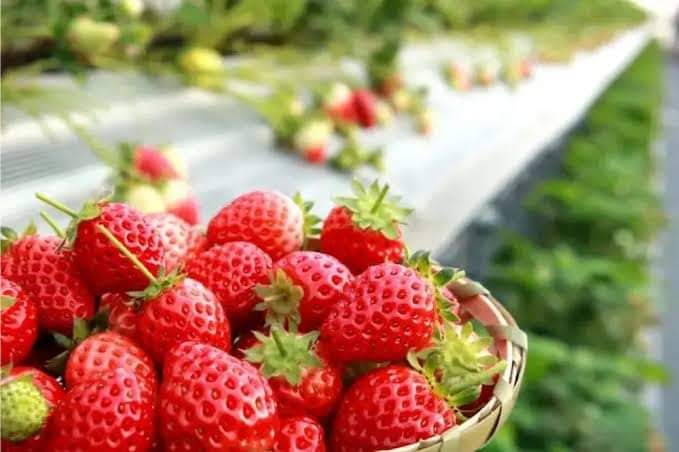Strawberry Farming and Its Business Potential In Nigeria
Strawberry Farming and Its Business Potential In Nigeria
Strawberry farming is an increasingly popular and profitable venture due to the high demand for fresh strawberries and strawberry-based products in local and international markets. This crop is valued for its rich flavor, nutritional benefits, and versatility in culinary uses. Below is a comprehensive overview of strawberry farming, including the cultivation process, business potential, and profitability factors.
1. Overview of Strawberry Farming
Strawberries are a small, red fruit with a sweet flavor and a high level of antioxidants, vitamins, and minerals. The plants are relatively easy to cultivate with proper care and can be grown in various climates, although they thrive best in temperate regions.
2. Ideal Conditions for Strawberry Cultivation
To achieve high yields and quality produce, strawberry farming requires:
Climate: Strawberries grow well in moderate temperatures (15-27°C) with cool nights and sunny days.
Soil: Loamy soil with a pH of 5.5 to 6.5, good drainage, and rich organic content is ideal.
Watering: Strawberries require consistent, moderate watering to maintain soil moisture without causing waterlogging.
Sunlight: They need 6-8 hours of sunlight per day to produce high-quality fruits.
Protection from Frost: Frost protection is essential, as frost can damage flowers and reduce yields.
3. Strawberry Cultivation Process
The cultivation process includes several key steps:
Land Preparation: Clear the land of weeds, rocks, and debris. Soil testing is recommended to determine nutrient needs, and organic matter is often added to improve soil structure.
Variety Selection: Select strawberry varieties suitable for the climate and market demands. Popular varieties include Albion, Chandler, and Sweet Charlie.
Planting: Strawberries are planted as bare-root plants or runner transplants, spaced 12-18 inches apart in rows. The planting season depends on the climate, with planting often done in early spring or late summer.
Mulching: Organic or plastic mulching helps control weeds, retain soil moisture, and keep berries clean.
Fertilization: Fertilizers rich in potassium and nitrogen are applied based on soil tests.
Irrigation: Drip irrigation is preferred to provide a consistent moisture level without wetting the foliage.
Pest and Disease Management: Common pests include aphids, spider mites, and slugs. Diseases like powdery mildew, botrytis, and verticillium wilt can be managed with crop rotation, resistant varieties, and organic or chemical treatments.
4. Harvesting and Post-Harvest Handling
Strawberries are typically harvested 3-4 months after planting, when they are fully red and ripe. Harvesting should be done carefully to avoid bruising the delicate fruit. After harvesting:
Sorting and Grading: The fruits are sorted based on size and quality.
Packaging: Berries are packed in small punnets or containers to prevent damage.
Storage and Transportation: Strawberries have a short shelf life, so they need refrigeration and quick distribution.
5. Business Potential and Market Opportunities
Strawberry farming has significant business potential due to high demand across multiple sectors:
Fresh Market Sales: Selling fresh strawberries to supermarkets, grocery stores, and farmers’ markets is a primary revenue stream.
Processed Products: Strawberries are used to make jams, jellies, juices, frozen products, and even cosmetics.
Export Market: Exporting strawberries to regions with high demand and limited supply can be lucrative, especially for growers meeting international quality standards.
Agrotourism and U-Pick Farms: U-pick farms, where customers harvest their own berries, offer additional income streams and enhance community engagement.
6. Profitability Factors
The profitability of strawberry farming depends on various factors:
Market Demand and Pricing: High-quality strawberries can fetch good prices, especially in off-seasons when fresh supply is limited.
Yield per Acre: Yields vary by variety and farm management practices, typically ranging from 8,000 to 10,000 pounds per acre.
Cost of Production: Initial setup costs can be high, especially for irrigation systems, mulch, and quality seeds. Efficient farm management can reduce ongoing costs.
Pest and Disease Management: Preventative measures reduce losses and ensure higher quality, sellable produce.
Labor Costs: Strawberry farming is labor-intensive, particularly during planting and harvesting. Mechanization and efficient labor management can improve profitability.
7. Challenges in Strawberry Farming
Short Shelf Life: Strawberries are perishable, requiring fast and efficient logistics.
Pest and Disease Risks: Diseases can spread rapidly, so integrated pest management is crucial.
Seasonal Constraints: Not all climates allow year-round cultivation, though greenhouse production can extend the growing season.
Labor Dependency: Labor shortages can affect timely harvesting and quality.
8. Starting a Strawberry Farm Business
To enter the strawberry farming business, consider the following steps:
1. Create a Business Plan: Outline goals, expected costs, revenue projections, and marketing strategies.
2. Secure Land and Resources: Purchase or lease land suitable for strawberry farming and invest in necessary tools and infrastructure.
3. Obtain Quality Seeds or Plants: Source disease-free transplants from reputable nurseries.
4. Establish Sales Channels: Build relationships with buyers, such as retailers, wholesalers, and food processors.
5. Branding and Marketing: Develop a brand and packaging that reflects quality, organic practices (if applicable), and customer appeal.
Conclusion
Strawberry farming offers strong income potential with various avenues for sales and product diversification. Although it requires careful planning, initial capital investment, and management, the rewards are significant, especially in markets where strawberries are in high demand. Expanding into value-added products and utilizing efficient practices can further enhance profitability and sustainability, making strawberry farming an appealing choice for agripreneurs and investors alike.




